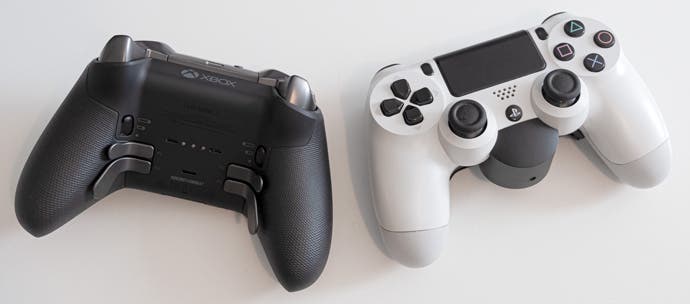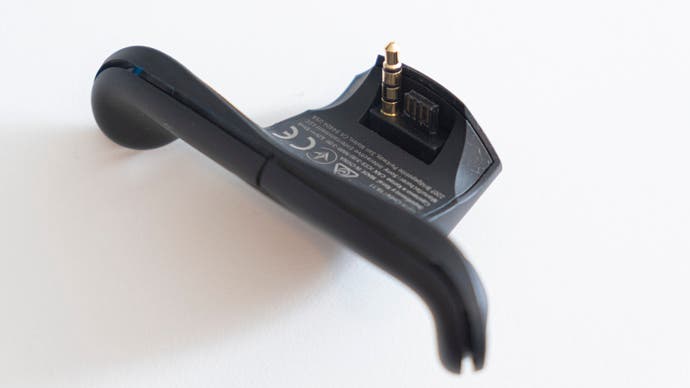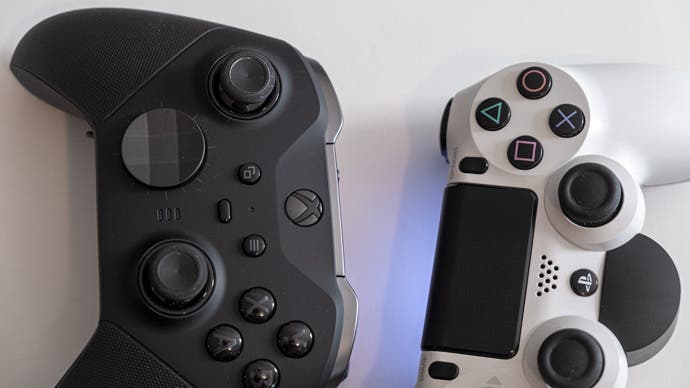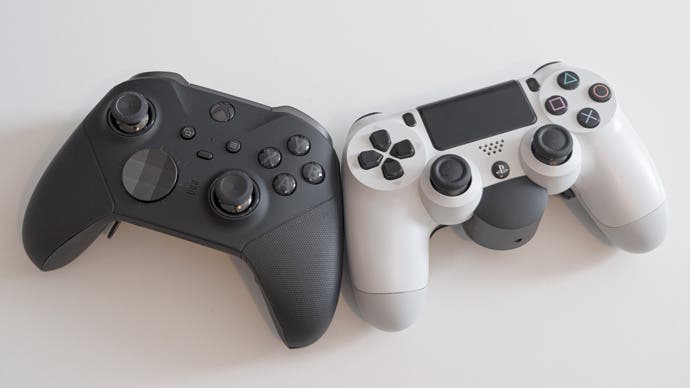DualShock 4 Back Button Attachment review: small but perfectly formed
A clever counter to the Microsoft's Elite Series 2 controller.
Microsoft's Elite Series 2 controller has been divisive. To its fans, the Elite is responsive, powerful and premium, the ultimate first-party controller, but its detractors can point to its high price and quality control issues to paint a different picture. That makes Sony's approach, almost diametrically opposite that of its rival, so refreshing. Rather than making an £160/$180 controller that only its most wealthy players can justify purchasing, Sony has created the £26/$30 Back Button Attachment, a snap-on device that adds the single most important feature of premium controllers - programmable rear buttons - to any standard DualShock 4 controller at an affordable price. We've been testing it for the past week ahead of its launch on February 14th, and we think Sony's approach has considerable merit.
Before we get into how this add-on performs, let's tackle the central thesis of the Back Button Attachment: that these buttons are genuinely useful and worth the extra cost and weight. The idea here is to keep the most important controls under your fingers at all times, even the ones that are normally bound to inconvenient buttons like the d-pad, share/options or L3/R3. For example, changing items in Dark Souls 3 requires you to press down on the d-pad, so if you're being chased by an enemy and get poisoned, you'd normally have to swap to your poison-clearing item and take your thumb off the left stick that controls movement, leaving you in an awkward position. Similarly, in Call of Duty, pressing down on the left stick all the time to sprint can be damaging to both the stick and your thumb, so mapping this to a rear paddle feels much more comfortable. And finally, what better way to change gears in Gran Turismo than with rear paddles? The more games you play with paddles, the more uses you'll find for them - and knowing that you can always rebind the two most awkward controls is a great comfort, especially when so few games offer complete control customisation.

Of course, just having rear paddles isn't enough to make a great controller. We've tested plenty of third-party controllers that have these rear buttons, but they can be inconveniently positioned, making them too hard to press or too easy to trigger accidentally. Another common pitfall is programming the buttons in the first place; often the setup process is so involved that it's only worth doing for the games that you play often, and you lose all interest in experimentation. A truly great rear paddle implementation should therefore satisfy two conditions: proper positioning and easy reprogramming. Happily, the Back Button Attachment absolutely drills these requirements.
Let's look at the physical side of things first. The Attachment's twin paddles are attached to a circular centre section, which contains an OLED screen, a 3.5mm passthrough port on the bottom and 3.5mm and data plugs on the opposite side. These plugs are mounted on a swivel, allowing the unit lock into place like a limpet on the bottom of the DualShock 4. Installing the Back Button Attachment takes a bit of doing the first time, but once you get the knack of inserting the tip of the 3.5mm plug and then pushing up to secure the unit, it takes only a couple of seconds to accomplish.

Once installed, the Attachment sits beneath the natural resting position of your middle or ring fingers, making it easy to actuate but with enough resistance to prevent accidental presses. The slim dimensions and tight placement keep the paddles from being triggered when the controller is placed on a flat surface too, another common annoyance with rear button controllers.
In our testing, we found the Attachment particularly useful for competitive shooters like last year's Call of Duty Modern Warfare, where reacting quickly to threats can mean the difference between topping the scoreboard and an ignoble defeat. We used the left paddle for sprinting, replacing a tiring thumb stick press, and the right paddle for jumping, allowing us to aim while in mid-air. After getting to grips with the new controls over the course of a couple of free-for-all matches, the game became more comfortable to play and that in-air aiming was a difference-maker in a few engagements - and all without any accidental presses in frantic moments. That suggests that the placement here is genuinely excellent, so full marks so far.
Programming comes next, and here the Back Button Attachment also excels. Flip the controller over, and you'll see that small circular OLED screen we mentioned earlier. Press and hold the screen to enter programming mode; you'll see the current profile (one to three) in the centre and the current bindings for each paddle on their respective sides. Each time you press the paddle with the screen engaged, it moves on to the next button assignment, looping through all possible options. With only sixteen possible bindings (including every button on the controller apart from Share and the PS button) and a fluid on-screen representation of your current choice, it only takes a few seconds to locate the button you're after. You can also assign a paddle to nothing, signified with a Ø symbol, to disable it. Once you're happy with your mapping, simply stop pressing buttons and the assignment is saved.

Switching profiles is similarly straightforward; just press the screen once to turn it on, then double tap to change to the next profile. It would have been nice to see more than three profiles, but this should be enough for most people given how easy it is to make new button assignments on the fly if needed.
These profiles persist across platforms, even if the Attachment is physically disconnected, so you can use your bindings on a friend's PlayStation as easily as you can your home console. Similarly, as all programming is done on the device itself, you can set and use the same bindings on PC, iOS, Android as well as PlayStation 4 systems, which is a brilliant alternative to the app-centric approach Microsoft took with the Elite Series 2 controller.
So excellent placement, easy reprogramming and multi-platform utility - that's a strong start, and already enough for us to recommend the Back Button Attachment to anyone with a DualShock 4 controller. However, how does Sony's new flagship controller loadout compare with Microsoft's Elite Series 2 for users looking for a quality gamepad to use on PC or mobile?

Obviously, this isn't a fair fight. Even if you pick up a brand new DualShock 4 controller for £45/$60 instead of using the one that came with your console, you'd still only be plunking down 71 quid or 90 of your US dollars for the up-gunned DualShock 4, less than half the cost of the £160/$180 Elite Series 2. With that said, the comparison is a fascinating one, with a definite gulf in quality and features between the two competing solutions.
While the DualShock 4 is well built, after using the 345g Elite Series 2 the Sony gamepad seems to lack heft at only 235 grams with the Attachment in place and 210 grams without. Its face buttons also lack the tactile snap of the Microsoft ultra-premium option, while the shorter triggers that aren't at satisfying to use and lack rumble. In general, the DualShock 4 feels less responsive and less precise to use. It's not bad by any means, but the build quality and tactility of the Microsoft controller is indisputably superior. There's a big disparity in features and customisability too, with the Sony controller offering no option to swap out sticks, adjust stick tension, rebind buttons, set dead zones and more.
All that said, we still believe the Back Button Attachment is the superior value for PC owners. Having access to those rear buttons has genuine worth in almost every game, while the added precision and longer feature list of the Elite 2 is only sometimes a difference-maker - usually in fast-paced and competitive titles. Put another way, the Elite Series 2 is six times as expensive than the Back Button Attachment, but does it offer six times the comfort? Six times the competitive advantage? Six times the utility? Even with all these factors considered, it's hard to see the Back Button Attachment as anything other than the better bang for buck choice.

We have to conclude that Sony's Back Button Attachment is a worthy upgrade for DualShock 4 owners, whether you're playing on PlayStation, PC or elsewhere. The idea of providing the single most essential piece of a premium controller at a relatively low cost is a great one, and the sheer utility this adds to a wide range of games across multiple platforms is hard to overstate. That premise could have been squandered in the implementation, but the Attachment's convenient positioning and easy programming ensure it feels like a natural piece of the controller rather than a last minute add-on.
Our only major complaint is that the Back Button Attachment comes so late in the life cycle of the PlayStation 4, on the eve of the PlayStation 5. Of course, that in turn raises the exciting possibility that Sony will include similar functionality in its next-gen console. Patent diagrams filed by Sony last year (and spotted by Dutch outlet LetsGoDigital in December) show a controller with four rear paddles, indicating that Sony is at least considering a change to the venerable DualShock design. Perhaps, instead of a late addition to the current-gen PlayStation, this is an early peek at the next-gen model. Wouldn't that be cool?

